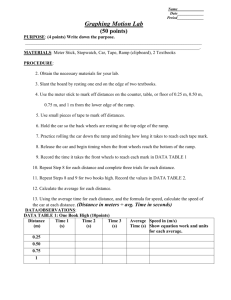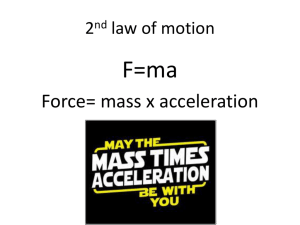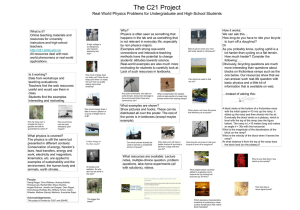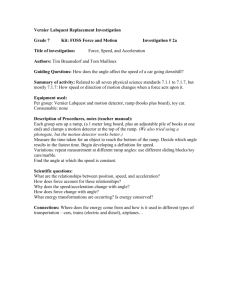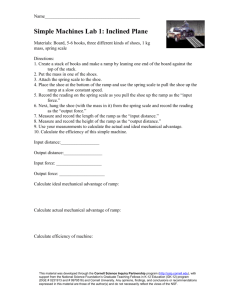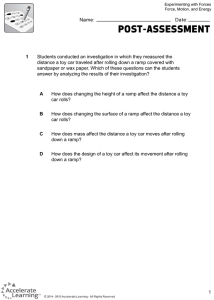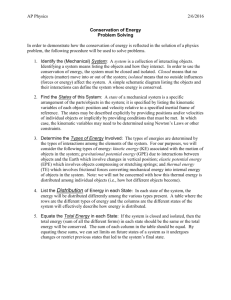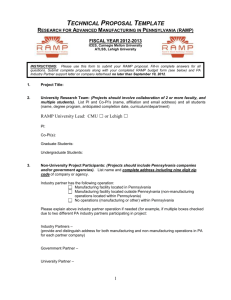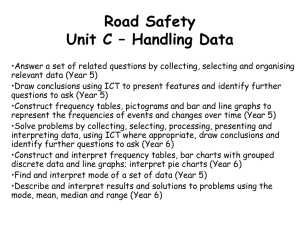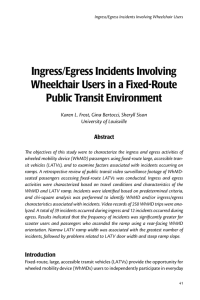Force and Motion
advertisement
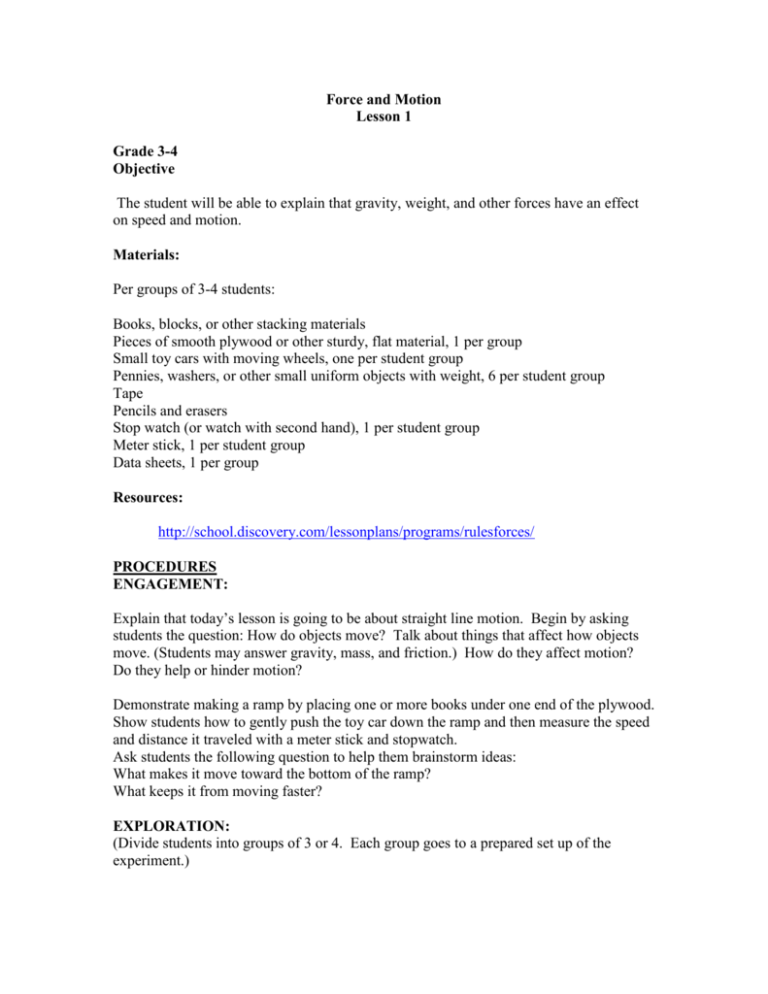
Force and Motion Lesson 1 Grade 3-4 Objective The student will be able to explain that gravity, weight, and other forces have an effect on speed and motion. Materials: Per groups of 3-4 students: Books, blocks, or other stacking materials Pieces of smooth plywood or other sturdy, flat material, 1 per group Small toy cars with moving wheels, one per student group Pennies, washers, or other small uniform objects with weight, 6 per student group Tape Pencils and erasers Stop watch (or watch with second hand), 1 per student group Meter stick, 1 per student group Data sheets, 1 per group Resources: http://school.discovery.com/lessonplans/programs/rulesforces/ PROCEDURES ENGAGEMENT: Explain that today’s lesson is going to be about straight line motion. Begin by asking students the question: How do objects move? Talk about things that affect how objects move. (Students may answer gravity, mass, and friction.) How do they affect motion? Do they help or hinder motion? Demonstrate making a ramp by placing one or more books under one end of the plywood. Show students how to gently push the toy car down the ramp and then measure the speed and distance it traveled with a meter stick and stopwatch. Ask students the following question to help them brainstorm ideas: What makes it move toward the bottom of the ramp? What keeps it from moving faster? EXPLORATION: (Divide students into groups of 3 or 4. Each group goes to a prepared set up of the experiment.) 1. Experiment with the ramps, rolling their cars down different height ramps to see what height allows the car to go the fastest down the ramp. a. What does increasing or decreasing the angle of the ramp do for the motion of the car? ____________________________________________________________ 2. Stick to the angle of ramp they found works the best for the remainder of the lesson. 3. Elect a record keeper to record data and a timer. 4. Conduct 3 different experiments which will each consists 3 trial runs. The first experiment will be to roll the car down the ramp with no added material. 5. Record the time it takes for the car to roll down the ramp and the length of the ramp for each of the 3 trial runs. Calculate the speed for each trial and then average the three speeds. 6. Add one of the materials to the car (using tape if necessary to hold the object on top of the car). 7. Record the time it takes for the car to roll down the ramp and the length f the ramp for each of the 3 trial runs. Calculate the speed for each trial and then average the three speeds. EXPLANATION: Did the car move faster or slower with the added weight? __________________________________________________________________ Why do you think this is? Talk about mass and how it affects speed. __________________________________________________________________ What if we put some more mass on top of the car? What will happen this time? __________________________________________________________________ ELABORATION: 1. Repeat the experiment the third time using a different material on the car. 2. Feel the pennies, washers, or other metal objects and talk about their weights. 3. Then tape three pennies or washers onto the top of their toy car. 4. Hypothesize whether this added weight would make the car move faster or slower. 5. Roll the car down the ramp three times, recording the time and distance for each separately. Calculate the average speed. Then find the average of the three trials. Did the car move faster or slower with the added weight? __________________________________________________________________ Why do you think this is? Talk about mass and how it affects speed. __________________________________________________________________ 6. Tape the remaining objects on the top of the car. What will happen this time? __________________________________________________________________ 7. Record your hypotheses before conducting three more trials, remembering to record the time and distance from each trial and then find the average. Calculate the speed. EVALUATION: 1. Students will discuss the hypotheses they made about the third experiment and answer the following questions. Were your hypotheses correct? ________________________________________________________________ What helped you to develop your hypotheses? ________________________________________________________________ What forces are at work making the car move differently with the added weight? ________________________________________________________________ 2. Students will explain the effect a greater mass had on the movement of the car. 3. Students will have an open discussion about gravity and friction. Summative Student Assessment: Teacher will assess students throughout the activity in the classroom, and by reviewing completed data sheets after experiments have been completed. Follow-Up/Homework: Students will be encouraged to conduct similar experiments at home to gain better understanding of gravity, motion, and mass. Submitted by: Perla Alega Paulette Chung Editha Obejero
